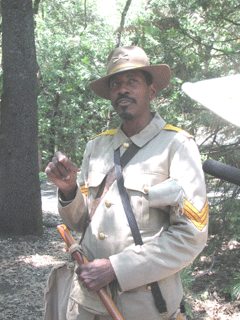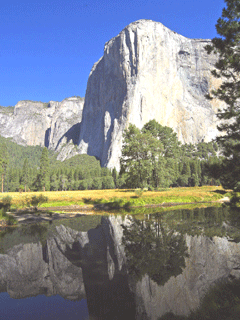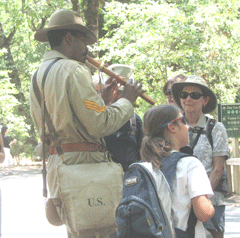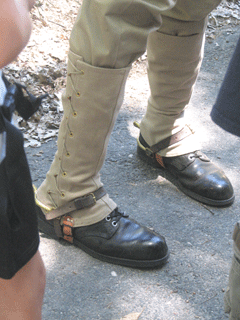Interpreting History
Air Date: Week of July 25, 2008

Park Ranger Shelton Johnson becomes Sergeant Alizy Bowman to tell the history of the beginnings of Yosemite National Park. (Photo: Melissa Frank)
African American Park Ranger Shelton Johnson channels Sergeant Alizy Bowman, bringing back a Buffalo Soldier who helped guard Yosemite National Park just after its creation. Producer Jim Williams went to the park and has our profile.
Transcript
CURWOOD: Two hundred and fifty million Americans visit our National Parks every year. We have nearly 400 of them in all. Most of them are patrolled by rangers who protect the park and talk about its geography, geology, plants and animals. And some feature interpretive rangers, who take on a character to help visitors understand the unique history of the park. One such ranger welcomes visitors to one of the most beautiful spots in the West, Yosemite. Jim Williams of member station KUMN caught up with this ranger in action.
JOHNSON: Have you noticed there’s just so much sky here? I think there’s a overabundance of sky in Yosemite. I wonder if the sky needed to get a permit from the government to have so much of itself over here.
WILLIAMS: South Carolina native Sergeant Alizy Bowman stands surrounded by fifteen or so wide-eyed Yosemite visitors. He’s decked out in his tan 9th cavalry finest. The crossed swords on his brimmed military hat flash in the bright sunlight.

One of Yosemite's best known landmarks: El Capitan (Photo: Jon Sullivan)
WILLIAMS: Everyone in this group raises a hand. It’s not surprising: Bowman is using Half-Dome as his own personal backdrop—the nearly-vertical granite cliffs shine through the massive incense-cedars and ponderosa pines on the Yosemite Valley floor. And of course, this isn’t really Sergeant Alizy Bowman. It’s Shelton Johnson, an African-American Interpretive Ranger who’s essentially reincarnated the sergeant’s character. In fact, Johnson’s been getting into this character in front of visitors here for about five years now. From his research, Johnson found out that Sergeant Bowman was a Buffalo soldier, a member of a group of African-Americans who helped guard Yosemite just after its creation. Bowman spent several summers in the early 1900s patrolling the backcountry looking for poachers and timber-thieves.
JOHNSON: And the people in this county—Mariposa County—are used to coming up into these mountains and getting what they want, what they need to help their family from these mountains. People come up here, and have for years, to shoot the game, to cut the trees down for firewood, and all of a sudden, the government steps in and says that there’s a line right here. Right here. And that line, on this side, is Yosemite National Park. On that side is Mariposa County. Now how many of you see that line? If you from Mariposa County, there ain’t no line there at all.

Sergeant Alizy Bowman, aka Ranger Shelton Johnson, plays his flute for Yosemite National Park visitors. (Photo: Melissa Frank)
JOHNSON: I gotta ask you folks something: is there a nice way to call someone a timber thief and a poacher? And if we were in Mississippi, or Alabama, or Georgia, and I was gonna call a white man a timber thief and a poacher, ain’t there a word for that down south? Oh, I remember, it’s called suicide.
[LAUGHTER]
WILLIAMS: The laughter turns to quiet, and there’s a moment here where Johnson’s audience seems to consider something a bit deeper, but the ranger moves them on quickly to another spot, playing his Native American flute along the path.
[FLUTE MUSIC]
WILLIAMS: He stops, points to a place for the kids to sit in the shade, and Alizy Bowman is back.
JOHNSON: Man, do you think I got a bit of a attitude?
WILLIAMS: He explains that he’d had an attitude growing up in Spartanburg, South Carolina, which didn’t go over well in the late 1800s. It’s a big part of the reason he ended up a Buffalo Soldier. His father, he says, told him to leave home as a teenager and walk north, which he did. Then he went west, eventually ending up in Fort Robinson, Nebraska, where he was extended an offer to join the Army. Bowman says as he held the pen to sign his enlistment form, he remembered that his brother had died in the Civil War, after having escaped slavery in South Carolina.

Park Ranger Shelton Johnson becomes Sergeant Alizy Bowman to tell the history of the beginnings of Yosemite National Park. (Photo: Melissa Frank)
WILLIAMS: Johnson bases his performance on his late father’s personality, and says through the performance, his father, and the Buffalo Soldiers, live on.
VISITOR: Thank you so much!
JOHNSON: You’re welcome. Thank you.
WILLIAMS: And for the visitors here today, none of whom are African-American, the impact is clear.
MAN 1: This man has a true gift as a storyteller. I would come back every day to hear this if I could. I feel like I’m a lot better educated about it, and I really appreciate that.

The intricate lacing of the spats of Sergeant Alizy Bowman's 9th cavalry uniform. (Photo: Melissa Frank)
JOHNSON: It’s a secret.
MAN 2: Yeah, I figured it was a secret. He just acts the part really, really well.
WOMAN: It just makes it a much richer experience than having, you know, someone tell you about history, it gives you the feeling of experiencing history.
MAN 3: And I think the country’s probably full of stories like this if we really knew the history and the individuals who were involved in these things.
WILLIAMS: Johnson says for him, the opportunity to share Bowman’s character with park visitors is too good to pass up.
JOHNSON: I think that this story provides a cultural window. A window into another way of looking, into another way of being—that some people have never looked through that particular window. And so this provides them an opportunity to not just see another person’s point of view, but to see themselves through that other window, how they may be seen through that other window.
WILLIAMS: But Johnson believes he’s also having an impact on African-American park visitors.
JOHNSON: They come into this setting and there may be some anxiety, because it’s away from urban areas. They’re doing something that a lot of African-Americans historically have not done in terms of visiting national parks and wilderness areas. And so when they hear this story, it’s like a safe-house, or an environment of not necessarily comfort, but it gives them a sense that ‘oh we belong here, this is the place that we’ve done this work, that we helped protect. This is our park.’ And they start seeing Half Dome, they start seeing El Capitan in a completely different way, because now it’s part of the African-American experience, to be in Yosemite.
WILLIAMS: Johnson regularly does his Alizy Bowman presentation for kids of color from nearby places like Fresno, Los Angeles, Sacramento, and San Francisco. The kids come to understand that some of Yosemite’s earliest protectors faced some of the same challenges they face today. Johnson says, for him, it’s also a way to make sure the history book isn’t missing a chapter.
JOHNSON: I think that stories that are forgotten, that we pay no attention to, just fade away, like an old soldier, you know? But stories that get that attention, that engage the mind, that engage the vision, that invigorates the story, that puts blood into the story, and the story can just live and live on and live on and live forever.
[FLUTE MUSIC]
WILLIAMS: And to help ensure just that, Shelton Johnson is writing a book on the Buffalo Soldiers of Yosemite. It’ll be called “Gloryland.” He’s also been interviewed by Ken Burns for a PBS documentary on the parks. His is a rising star, and Alizy Bowman is right there rising with him.
For Living On Earth, I’m Jim Williams from Yosemite National Park.
Links
Yosemite Interpretive Ranger Shelton Johnson's Shadow Soldier website
Living on Earth wants to hear from you!
Living on Earth
62 Calef Highway, Suite 212
Lee, NH 03861
Telephone: 617-287-4121
E-mail: comments@loe.org
Newsletter [Click here]
Donate to Living on Earth!
Living on Earth is an independent media program and relies entirely on contributions from listeners and institutions supporting public service. Please donate now to preserve an independent environmental voice.
NewsletterLiving on Earth offers a weekly delivery of the show's rundown to your mailbox. Sign up for our newsletter today!
 Sailors For The Sea: Be the change you want to sea.
Sailors For The Sea: Be the change you want to sea.
 The Grantham Foundation for the Protection of the Environment: Committed to protecting and improving the health of the global environment.
The Grantham Foundation for the Protection of the Environment: Committed to protecting and improving the health of the global environment.
 Contribute to Living on Earth and receive, as our gift to you, an archival print of one of Mark Seth Lender's extraordinary wildlife photographs. Follow the link to see Mark's current collection of photographs.
Contribute to Living on Earth and receive, as our gift to you, an archival print of one of Mark Seth Lender's extraordinary wildlife photographs. Follow the link to see Mark's current collection of photographs.
 Buy a signed copy of Mark Seth Lender's book Smeagull the Seagull & support Living on Earth
Buy a signed copy of Mark Seth Lender's book Smeagull the Seagull & support Living on Earth

